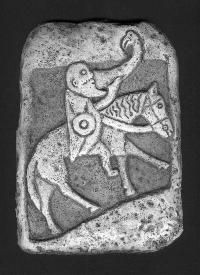DARK MIST RISING: AVALON UNVEILED: RE-INTRODUCTION:
A ninth century, mounted Pictish warrior either drinks from or blows upon an eagle-headed horn. From a carved Pictish stone at Invergowrie, Scotland, now in the Museum of Scotland. {{PD-US}}
Amazons, Scythians, and Picts: all names out of legend. Ancient Greeks such as Homer and Herodotus reported Amazons dying on the beaches of Troy, harboring Heracles, and, most astonishing of all, fighting Greeks with spears and arrows. The patriarchal Greeks were mystified and horrified by these fighting women. Some of them, like Alexander the Great, who is said to have hunted lions with the Amazon “queen”, Thalestris, were enthralled with them. Others, like Achilles, were dismayed to find themselves in combat with women who considered themselves on a par with, and even superior to, men. The ongoing Greek fascination with Amazons transmitted itself onto the ferocious figures depicted on their pottery, many pieces of which survive to this day.
Out of the Amazon culture was said to have grown that of the Scyths. Herodotus reported that the Amazons sought out one of the steppe tribes and intermarried with them: the children of this union became the Scythians. Today, many Scythian kurgans, or grave-mounds, are yielding evidence of a woman-warrior culture amongst the ancient peoples of the steppes.
Even more intriguing – and shrouded further in the mists of obscurity – is an archaic myth about the Picts. While still wandering on the continent and before emigrating to the British Isles, the Picts encountered the Celts. The two agreed to become allies and that, when- and wherever one of them settled in future, the first would find a home – or “swordland” – for the latecomer. This was borne out later, when the Irish (Celts) made room for their Pictish friends in Alba (Scotland). Specifically, Conall Corc – the famous chieftain who later gave his name to the southern Irish city of Cork (after conquering Munster) and was at the time attempting to colonize the Lennox Region of Scotland – brought Fergus mac Muiredach and his part-Pictish daughter, Leamhan, the Elm, (who apparently caught Corc’s eye on this journey, later becoming his second wife), along as mercenaries to help with the colonization.
Maybe the myth was created to explain these “strange bedfellows”. But was an explanation really necessary? Once both had settled in the British Isles, the two cultures appear to have been natural allies: they had common enemies, similar customs (in fact, scholars continue to debate whether the Pictish language and culture is some kind of subset of the Celtic one), and inhabited some of the same areas.
Coming across this story in my research for my historical fiction series, The Annals of Anavere, I wondered: What if there was something more to it than just an old legend? In this blog, Dark Mist Rising: Avalon Unveiled, I will attempt to connect the three cultures – Amazon, Scythian, and Pict – by means of the ancient dots that remain extant: archaeology, art, and literature. First, let’s start with horses.
BIBLIOGRAPHY:
Herodotus. “Herodotus: On the Scythians.” Metmuseum.org, Metmuseum.org, 2019, www.metmuseum.org.
Silver, Carly. “Meet the Amazon Warriors Who Brought the Greeks to Their Knees.” ThoughtCo, ThoughtCo, 25 May 2019, www.thoughtco.com/amazon-queens-who-rocked-ancient-world-4012619.
Vergano, Dan. “Amazon Warriors' Names Revealed Amid ‘Gibberish’ on Ancient Greek Vases.” National Geographic, National Geographic Society, 23 Sept. 2014, news.nationalgeographic.com/news/2014/09/140923-amazon-greek-vase-translations-science/.
Watson, William J. The History of the Celtic Place-Names of Scotland. Birlinn, 2004.


Comments
Post a Comment